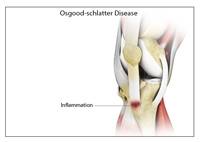
Osgood-Schlatter disease is a common knee problem seen in growing adolescents.
What is Osgood Schlatter Disease?
Osgood-Schlatter disease refers to a condition in older children and teenagers caused by excessive stress to the patellar tendon (located below the kneecap). Participants in sports such as soccer, gymnastics, basketball, and distance running are at higher risk for this disease.
Causes
The causes of Osgood-Schlatter disease include:
Outdoor sports activities involving a lot of running and jumping exerts stress on the thigh muscles, which in turn pulls the patellar tendon that connects the kneecap to the tibia. Repeated stress can cause the tendon to shift away from the tibia, causing pain and swelling of the affected knee. In some cases, the body may try to close the gap with new bone growth which results in a bony lump in that region.
Symptoms
The main symptoms of Osgood-Schlatter disease include:
- Knee pain
- Swelling
- Tenderness below the kneecap area
Diagnosis
Diagnosis of Osgood-Schlatter disease includes a review of your symptoms and medical history. A physical examination will be performed by your doctor to check the affected knee for pain, swelling, and inflammation. X-ray or MRI scanning may be ordered to view the bones of the knee and examine the tendon and tibia more closely.
Treatment
The goal of treatment is to reduce pain and swelling. The treatment includes the use of anti-inflammatory medications and physical therapy. Physical therapy may include strengthening exercises for the thigh muscles to help stabilize the knee joint. Most Osgood-Schlatter symptoms disappear after the adolescent growth spurt has ended.
Related Topics
- Patellar Instability
- Multiligament Instability
- Patellofemoral Instability
- Posterolateral Instability
- Knee Arthritis
- Knee Osteoarthritis
- Knee Injury
- Knee Pain
- Anterior Knee Pain
- Meniscal Tears
- Runners Knee
- Jumpers Knee
- Unstable Knee
- Knee Sprain
- MCL Sprains
- ACL Tears
- MCL Tears
- Meniscal Injuries
- PCL Injuries
- Ligament Injuries
- Knee Fracture
- Fractures of the Tibia
- Patella Fracture
- Tibial Shaft Fracture
- Kneecap Bursitis
- Chondral or Articular Cartilage Defects
- Quadriceps Tendon Rupture
- Patellar Tendon Rupture
- Lateral Meniscus Syndrome
- Osteonecrosis of the Knee
- Knee Angular Deformities
- Osteochondral Defect of the Knee
- Articular Cartilage Injury
- Goosefoot Bursitis of the Knee
- Iliotibial Band Syndrome
- Bowed Legs
- Recurrent Patella Dislocation
- Osteochondritis Dissecans of the Knee
- Chondromalacia Patella
- Patellar Tendinitis
- Knee Sports Injuries
- Multiligament Knee Injuries
- Women and ACL Injuries
- Medial Meniscus Syndrome
- Tibial Plateau Fracture
- Tibial Eminence Fractures
- Loose Bodies in the Knee
- Osgood Schlatter Disease
- Patellar Dislocation/Patellofemoral Dislocation








